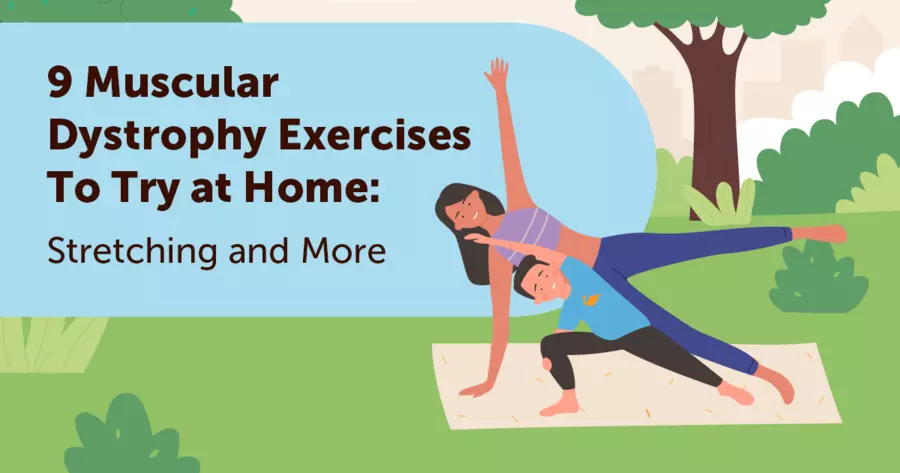9 Muscular Dystrophy Exercises To Try at Home: Stretching and More



Physical therapy and exercises like stretching are an important part of treatment for your child’s Duchenne muscular dystrophy (DMD). They may be used with other treatment options like medications, gene therapies, and more. Exercises can help muscles stay strong, so they can continue working as well as possible. Consistent exercises can also make it easier for your child to use home modifications like grab bars and ramps.
Several types of exercises may be good for your child with DMD. Stretching is one example. Stretching can help muscles stay more flexible, limit or prevent contractures, and maintain range of motion. Most of the time, your child will need your help to complete these movements effectively.
Talk to your child’s doctor or physical therapist before you start any stretching routine or change an exercise program you’ve been following. Your doctor will help keep your child safe and tell you what to look for when you help your child stretch. A health care provider will also be able to monitor your child for signs that they should stop stretching or change their daily routine to help maintain their quality of life.
Here are nine exercises you can try with your child with DMD.
1. Side Twist Wrist Stretch
This stretch helps loosen muscles in your child’s wrists.
- Have your child sit up straight on a bed or bench.
- Place their hand flat on the surface they’re sitting on, fingers turned out 90 degrees from the body.
- Help them keep their fingers flat.
- Support their elbow so it doesn’t collapse, though it doesn’t need to be locked.
- Hold for 30 to 60 seconds, three times. Repeat with the other hand.
2. Seated Finger Extension
This stretch helps the muscles in your child’s fingers and hands to stay loose and limber.
- Have your child sit comfortably.
- Extend their arm with the elbow at approximately a 90-degree angle.
- Standing beside or behind them, hold their palm with both hands.
- Gently extend the palm.
- Slide your hands slowly down your child’s hand, extending the palm and then the fingers towards the floor.
- Hold for 60 seconds, then release and repeat one more time. Repeat with the other hand.
3. Moving Hand and Wrist Stretch
This stretch involves moving the arms, rather than holding a steady stretch. It’s a range-of-motion exercise designed to keep muscles working in a variety of positions.
- Have your child lie on their back.
- Sit on the side of the arm you plan to stretch.
- Have your child extend their arm, and support your child’s elbow with one hand.
- With the other hand, hold their arm near the wrist. If you can, use this hand to also gently keep their fingers open.
- Move the arm from extended to bent at the elbow at least 90 degrees, if possible.
- Go back and forth from extended to 90 degrees at least 10 times. Rest, then repeat one or two more times. Repeat with the other arm.
4. Forearm Stretch
This stretch helps the muscles in your child’s forearms.
- Have your child lie on their back.
- With one hand, keep their elbow against the side of their body for the whole stretch.
- With the other hand, grasp their arm just above the wrist.
- Bend their elbow to 90 degrees with their hand in a palm-up position.
- Hold for 60 seconds. Release, then hold for 60 seconds again. Repeat with the other arm.
5. Hip Flexor Stretch
This stretch helps loosen your child’s hip flexors, which are at the front part of their pelvis and thighs.
- Have your child lie on their stomach.
- Stand on the side you plan to stretch with one of your knees up on the surface where they’re lying.
- Place one hand on their lower back on the side you’ll be stretching.
- Place the other hand under the knee of the leg you’ll be stretching.
- Gently lift their leg up while pushing their lower back slightly down.
- Hold for 30 to 60 seconds, then repeat two or three times. Repeat with the other leg.
6. Hamstring Stretch
This stretch helps lengthen the back of your child’s legs, particularly the upper thighs.
- Have your child lie on their back.
- Put your hand under one knee to support it.
- Using the other hand, gently lift their heel off the ground until they feel a stretch in the back of their leg.
- Keep the knee straight but not locked.
- Your child may feel this stretch down the entire back part of their leg or only in the upper part.
- Hold for 60 seconds, then release. Repeat one or two times. Repeat with the other leg.
7. IT Band Stretch
This stretch helps the muscles on the outside of your child’s thighs to stay flexible.
- Have your child lie on their stomach.
- Stand on the side you plan to stretch.
- With one hand, gently press down on your child’s lower back.
- Place the other hand under their knee and lift their leg.
- Gently swing their leg across their body’s center line and hold it there.
- Hold the stretch for 60 seconds, then release and repeat one more time. Repeat with the other leg.
8. Supine Calf Stretch
This stretch helps keep the muscles in your child’s calves flexible.
- Have your child lie on their stomach.
- Flex the knee of one leg to 90 degrees.
- Use one hand to stabilize their lower leg.
- Use the other hand to hold the bottom of their foot and their heel.
- Flex the foot as far toward the shin as possible.
- Hold for 60 seconds, release, then repeat. Repeat with the other leg.
9. Lying Achilles Stretch
This stretch helps keep the Achilles tendon (which connects the calf muscle to the heel bone) long and flexible.
- Have your child lie on their back with a small towel rolled up under their knees.
- Hold their heel with one hand and pull gently to lengthen the leg and the Achilles tendon.
- Gently help them flex their foot as far as possible without pain.
- Hold for 60 seconds, release, then hold for 60 seconds again. Repeat with the other leg.
Exercise Tips
These general stretching tips can help your child get the most out of their stretching routine.
- Warm up if you can. Moving your child’s body around gently can help their muscles get ready. If that’s impossible, consider applying heat to muscles before you stretch them.
- Keep track of form. Your child will get the most out of their stretches if their body is aligned properly while doing them. Working with a physical therapist or health care provider can help make sure you’re doing the stretches correctly and give you the confidence to do them at home.
- Don’t push until it hurts. This can be hard when you’re stretching someone else. Create a signal so your child can tell you to stop when they feel only mild tension in their muscles.
- Focus on breathing. Your child should not hold their breath while stretching. Part of helping them may involve reminding them to breathe regularly while stretching.
Exercise Resources
There are several resources you can turn to when you need help with stretches to do at home for DMD. CureDuchenne offers several videos on stretching to help Duchenne muscular dystrophy. They include background information on stretching and videos on self-stretching and helping your child stretch.
The Muscular Dystrophy Association offers a PDF for DMD parents on stretches you can do at home.
The National Center on Health, Physical Activity, and Disability offers an overview of exercise guidelines for people living with DMD.
Find Your Team
On myDMDcenter, the site for people with Duchenne muscular dystrophy and their loved ones, people come together to gain a new understanding of DMD and share their stories with others who understand life with DMD.
Have you or a loved one found stretches that help with Duchenne muscular dystrophy? How do you help your loved one with DMD exercise at home? Share your experiences in the comments below.
- Duchenne Muscular Dystrophy — MedlinePlus
- Duchenne Muscular Dystrophy — StatPearls
- Exercise Training in Duchenne Muscular Dystrophy: A Systematic Review and Meta-Analysis — Journal of Rehabilitation Medicine
- Stretching — CureDuchenne
- Physiotherapy Stretches for Duchenne Muscular Dystrophy — Duchenne and You
- Self-Stretching for Duchenne — CureDuchenneMD
- Six Tips for Safe Stretches — Harvard Health Publishing
- Stretching Videos — CureDuchenneMD
- At-Home Physical Therapy Exercises — Muscular Dystrophy Association
- Exercise Guidelines for Persons With DMD — National Center on Health, Physical Activity and Disability
 Federica Polidoro, M.D.
a graduate of medical school and neurology residency in Italy, furthered her expertise through a research fellowship in multiple sclerosis at Imperial College London.
Learn more about her here.
Federica Polidoro, M.D.
a graduate of medical school and neurology residency in Italy, furthered her expertise through a research fellowship in multiple sclerosis at Imperial College London.
Learn more about her here.
 Sarah Winfrey
is a writer at MyHealthTeam.
Learn more about her here.
Sarah Winfrey
is a writer at MyHealthTeam.
Learn more about her here.
Subscribe now to ask your question, get answers, and stay up to date on the latest articles.
Get updates directly to your inbox.
 Get trusted articles sent directly to your inbox.
Get trusted articles sent directly to your inbox.






We'd love to hear from you! Please share your name and email to post and read comments.
You'll also get the latest articles directly to your inbox.